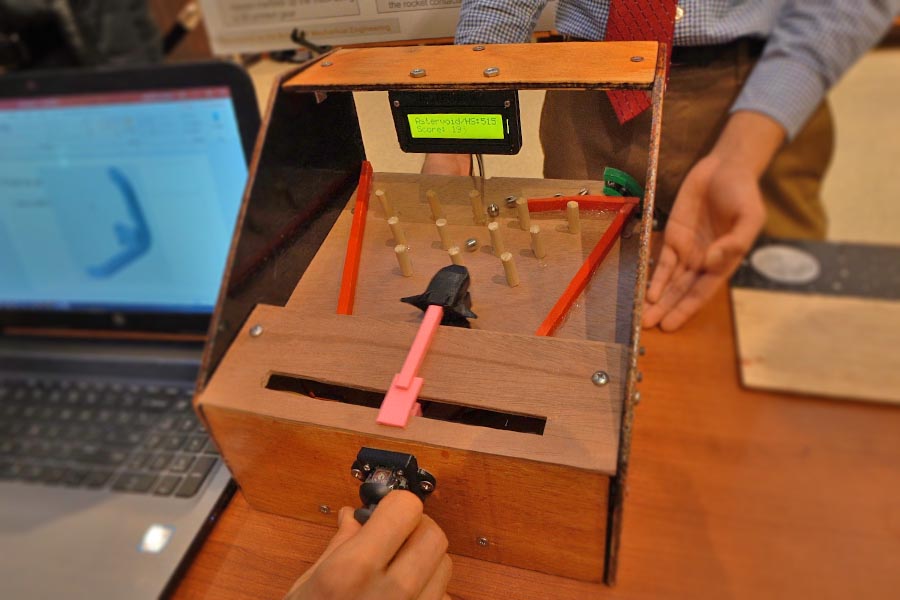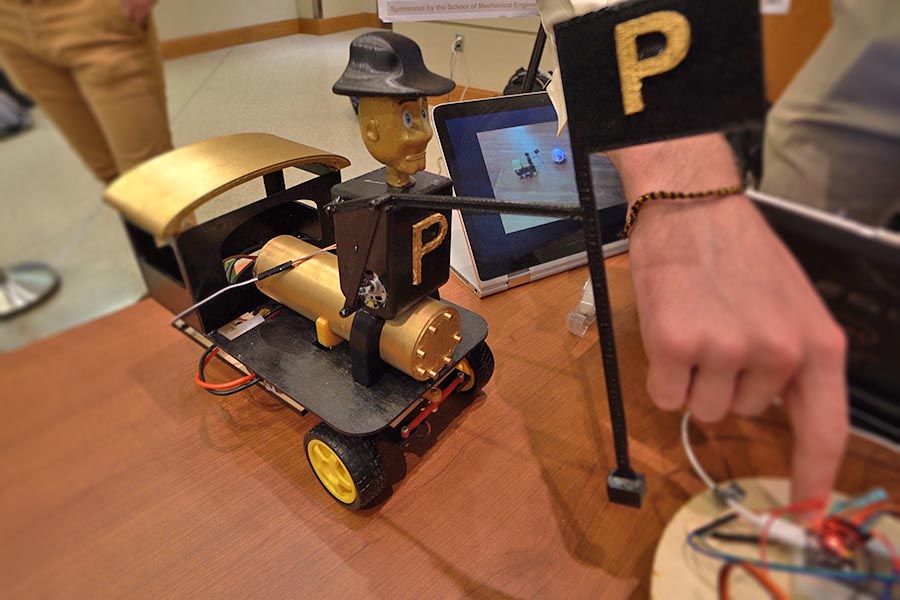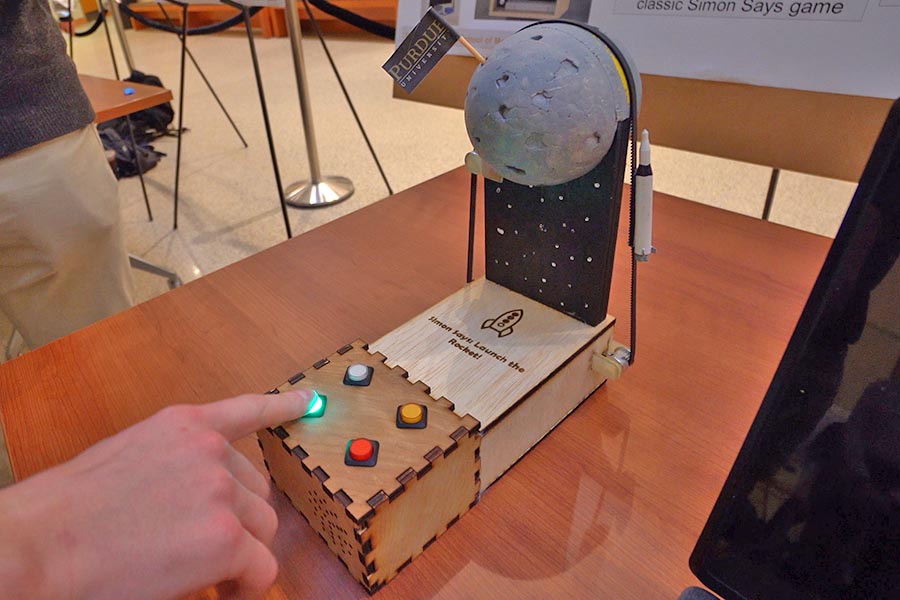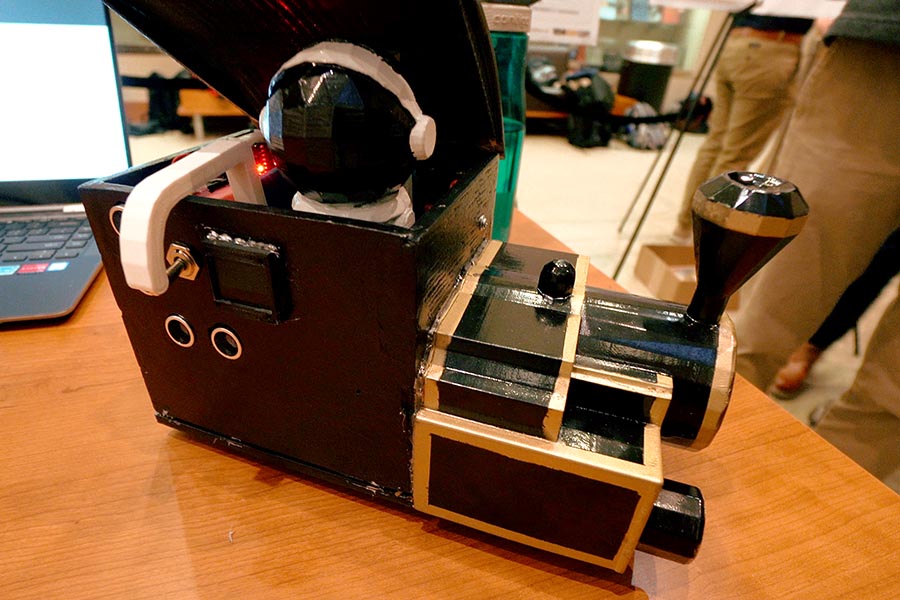Toy Fair showcases Boilermaker fun
The Toy Fair served as the final project of ME444, Computer-Aided Design (otherwise known as the Toy Design class.) Students learn concept generation, CAD design, finite element analysis, and rapid prototyping, and other skills necessary to work in industry. But all their hands-on learning takes place with toys, and their final project involves designing and building a new action toy. Their products are judged by industry experts, who visit Purdue every year for the Toy Fair.
Why toys? “Toys are the perfect metaphor for simulating the types of projects that engineers work on in the real world,” said Karthik Ramani, the Donald W. Feddersen Professor of Mechanical Engineering, who started the class in 1997. “Everyone played with toys when they were little, so they all know about the experience. But in this class, they learn how engineers and designers conceptualize and create those toys.”
“You could cover product design in the classroom,” said continuing lecturer Min Liu, who now teaches the class. “But our very first class is actually a lab. We want students to get hands-on as soon as possible, and toy design is a scaffolding that helps them learn the design process holistically. We call it the i6 framework: inspiration - ideation - imagination - iteration - implementation - innovation.”
As part of their final project, students team up to develop a brand-new toy, create a working prototype, and present it to a panel of judges at the annual Toy Fair. Through the years, students have created an incredible variety of toy concepts, from a remote-control chicken and autonomous octopus, to marble mazes and hydraulic cranes. Some are built around high-tech microcontrollers and sensors, while others are simple puppets or board games that don't even require batteries. The Mechanical Engineering building even hosts a Toy Museum, where dozens of these eclectic prototypes are on display. “We are very lucky to have this museum space,” said Ramani. “Every one of these toys has the potential to become an amazing product.”
The top winners from the Fall 2019 Toy Fair are:

Best Innovation Award: Astervoid, Brian Araya, Michael Anthony, Pashin Raja, Nikhil Carneiro. In this game, the user moves a rocket ship back and forth to "avoid" the "asteroids." A marble mover ejects marbles to the top of the plywood playing field, and wooden pegs slow down and randomize the marbles. A 3D-printed rocket with an embedded limit switch tracks if the rocket contacts a marble. Scores are calculated by how long the rocket can avoid the asteroids.

Best Engineering Award: Purdue Pete Space Chase, Adrianna Natoli, Kris Sjolund, Will Stolz. This cat-and-mouse style game features two vehicles, each one remotely controlled by a user with their smartphone. The goal for the Purdue Pete car is to plant his flag on the Moon, while the goal for the Moon car is to escape from Purdue Pete!

Best Market Potential Award: Simon Says Launch the Rocket!, Ryan Andrews, Shaaz Kantawala, Blake Larson and Jacob Peterson. This "Simon Says" game consists of a series of buttons with different colored lights and musical tones. The Arduino flashes the buttons in a random pattern, which the user must then duplicate. Each round, another light gets added to the pattern. If the user completes a certain number of levels, the rocket takes off!

Best Engagement Award: Boilermaker Useless Box, Konrad Swiatkowski, Angad Singh, Stephen Frank, Nathaniel Schadler. This Boilermaker Special model is inspired by the so-called "Useless Box," whose only function is to turn itself off. The train features an LCD display which asks the user to flip a switch, and then (with ultrasonic sensors) steers the train out of the way when the user's hand gets close to the switch. Eventually, an astronaut emerges from the train to flip the switch himself!
Ramani sees this class as a logical extension of the 21st century “maker” movement, which promotes technology as a means to create new items in the physical world. “The design element of engineering has grown in importance over the years,” said Ramani. “That's why we encourage our students to harness their creativity in a tangible way. We also constantly update the class to include the latest technologies, like 3D printing and laser cutting. Put together, it results in a cutting-edge education here at Purdue.”
Learn more at http://engineering.purdue.edu/toydesign
Writer: Jared Pike, jaredpike@purdue.edu, 765-496-0374
Source: Karthik Ramani, ramani@purdue.edu, 765-494-5725
Min Liu, liu66@purdue.edu, 765-494-9351
